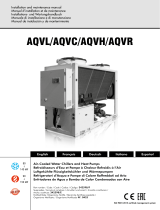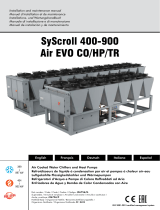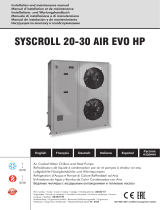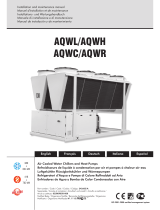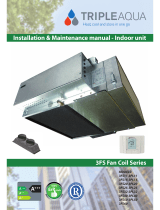
Page 3
English
2 SAFETY
2.1 Foreword
These units must be installed in conformity with the
provisions of Machinery Directive 2006/42/EC,
Pressure Equipment Directive 2014/68/EU, Elec-
tromagnetic Compatibility Directive 2014/30/EU,
as well as with other regulations applicable in the
country of installation. If these provisions are not
complied with, the unit must not be operated.
The unit must be grounded, and no instal-
lation and/or maintenance operations may
be carried out before deenergising the elec-
trical panel of the unit.
Failure to respect the safety measures mentioned
above may result in electrocution hazard and fire in
the presence of any short-circuits.
Inside the heat exchangers, the compres-
sors and the refrigeration lines, this unit
contains liquid and gaseous refrigerant un-
der pressure. The release of this refrigerant
may be dangerous and cause injuries.
The units are not designed to be operated
with natural refrigerants, such as hydrocar-
bons. Manufacturer may not be held liable
for any problems deriving from the replace-
ment of original refrigerant or the introduc-
tion of hydrocarbons.
Units are designed and manufactured according to the
requirements of European Standard PED 2014/68/
EU (pressure equipment).
n The used refrigerants are included in group II (non-
hazardous fluids).
n The maximum working pressure values are men-
tioned on the unit’s data plate.
n Suitable safety devices (pressure switches and
safety valves) have been provided, to prevent any
anomalous overpressure inside the plant.
n The vents of the safety valves are positioned and
oriented in such a way as to reduce the risk of con-
tact with the operator, in the event that the valve is
operated. Anyway, the installer will convey the dis-
charge of the valves far from the unit.
n Dedicated guards (removable panels with tools)
and danger signs indicate the presence of hot pipes
or components (high surface temperature).
The guards of the fans (only for units pro-
vided with air heat exchangers) must be al-
ways mounted and must never be removed
before de-energising the appliance.
It is the User’s responsibility to ensure that
the unit is fit for the conditions of intended
use and that both installation and mainte-
nance are carried out by experienced per-
sonnel, capable of respecting all the rec-
ommendations provided by this manual.
It is important that the unit is adequately
supported, as detailed in this manual. Non-
compliance with these recommendations
may create hazardous situations for the
personnel.
The unit must rest on a base which meets
the characteristics specified in this manual;
a base with inadequate characteristics is
likely to become a source of serious injury
to the personnel.
The unit has not been design to withstand
loads and/or stress that may be transmitted
by adjacent units, piping and/or structures.
Each external load or stress transmitted to the
unit may break or cause breakdowns in the
unit’s structure, as well as serious dangers to
people. In these cases, any form of warranty
will automatically become null and void.
The packaging material must not be dis-
posed of in the surrounding environment or
burnt.
2.2 Definitions
OWNER: means the legal representative of the com-
pany, body or individual who owns the plant where
unit has been installed; he/she has the responsibility
of making sure that all the safety regulations specified
in this manual are complied with, along with the na-
tional laws in force.
INSTALLER: means the legal representative of the
company who has been given by the owner the job
of positioning and performing the hydraulic, electric
and other connections of unit to the plant: he/she is
responsible for handling and properly installing the
appliance, as specified in this manual and according
to the national regulations in force.
OPERATOR: means a person authorised by the owner
to do on unit all the regulation and control operations
expressly described in this manual, that must be strict-
ly complied with, without exceeding the scope of the
tasks entrusted to him.
DANGER
DANGER
DANGER
DANGER
DANGER
DANGER
WARNING
WARNING
Safety




















